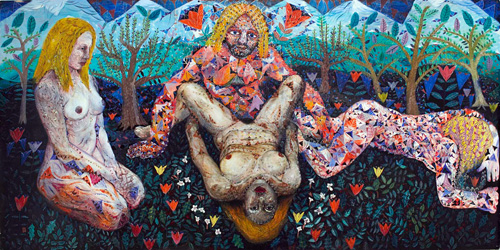"3"
Review
July 16, 2008

THE RAPE BY KYLE RANSON
For "3," artist Chris Duncan gathers a trio whose work explores pattern-making -- either through the mark itself (Kyle Ranson's decorated figures and Derrick Snodgrass' prismatic constellations) or ordering select bits of visual information (Ernesto Burgos' wall collage).
Bay Area artist Snodgrass' Easter egg-colorful watercolors on paper from 2000 are refracted architectural shapes dotted with sunspots. Between then and now, Snodgrass loosened his grip and minimized his palette. Untitled, a tapestry in shades of browns and blacks, records the physicality of making the work. An orb at the tapestry's center anchors a profusion of comet tails -- the splattered streams radiate outward to the infinite. Back here on earth, local artist Ranson's seven-panel The Rape depicts the Romans' so-called rape or abduction of the Sabine women, a story ultimately about maintaining familial lines. Ranson's rape is literal and explicit. The main male figure's deadened eyes stare somewhere over the viewer while his naked conquest's head tilts backwards, her steady gaze revealing nothing.
The action across the panels is disconnected: a sentry stands off to the right, his outsize hands hanging dumbly by his sides, and a woman lounges naked and unaware. And is that God above, grinning slightly?
New York City artist Ernesto Burgos' The Dumb Are Mostly Intrigued by the Drum offers a surrealistic plane where patterns and figures collide. A wall collage of black-and-white photocopies repeats photographic images of predatory birds, variously shaped atomic bomb clouds, lambs, a wide-eyed man whose mouth has been altered to a ghoulish grin, a naked woman whose wrists are bound in bondage ropes, and swatches of grids, to name a few. It isn't so much that we are interested in patterns but that patterns are dependent on us: how can we repeat mistakes if they don't make themselves recognizable? (KATIE KURTZ)